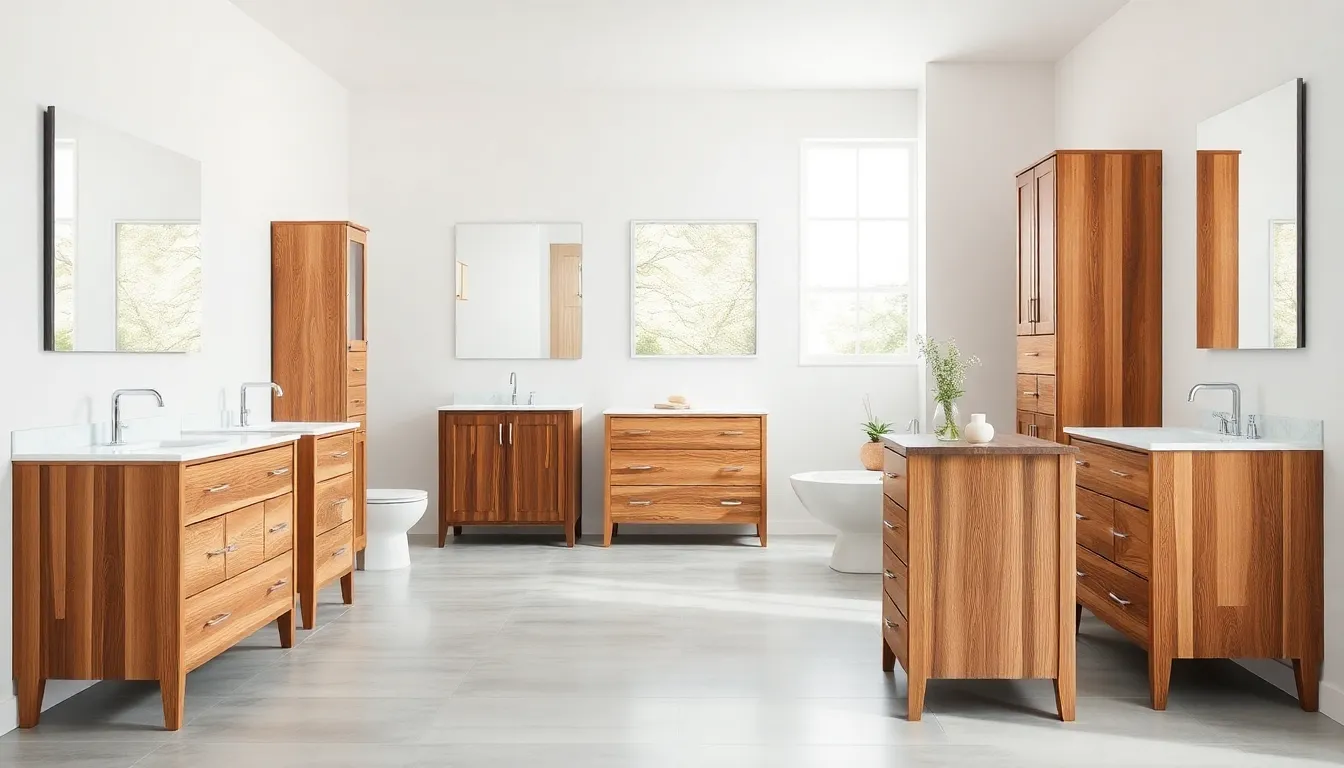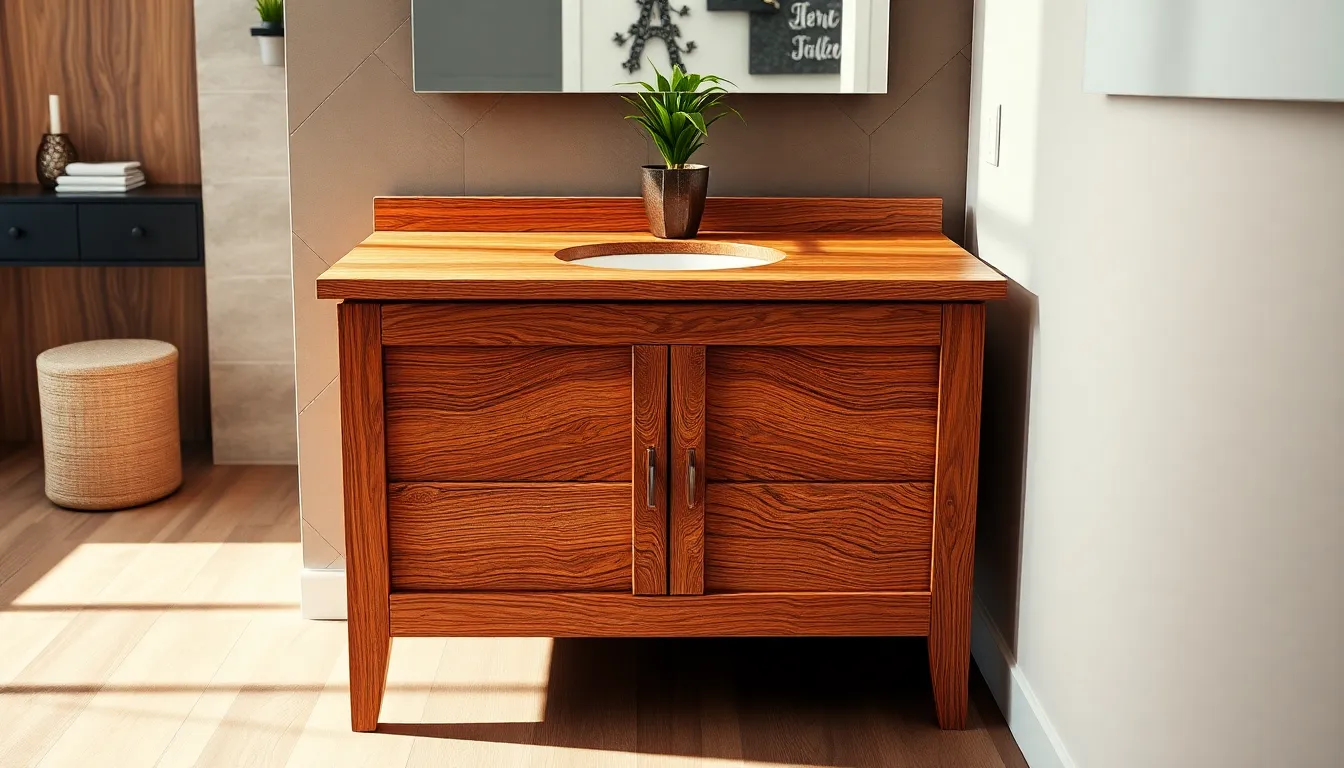When it comes to bathroom upgrades, choosing the right vanity wood can feel like a game of Goldilocks—too cheap and it’ll warp faster than a bad relationship, too expensive and you’ll be eating ramen for a month. But the perfect balance exists, and it’s not just about looks; it’s about durability, style, and a touch of personality.
Imagine a bathroom vanity that not only holds your essentials but also elevates your space from drab to fab. Whether it’s rustic oak or sleek walnut, the right wood can transform your bathroom into a sanctuary. Plus, let’s be honest—who doesn’t want a vanity that makes their morning routine feel like a luxury spa experience? Dive into the world of bathroom vanity wood and discover how to make your space not just functional, but fabulously inviting.
Table of Contents
ToggleOverview of Bathroom Vanity Wood
Bathroom vanity wood selection significantly impacts function and aesthetics. Common choices include oak, maple, cherry, and birch due to their durability and resistance to moisture. Oak, known for its strength, features prominent grain patterns that add visual interest. Maple showcases a smooth surface, making it ideal for modern designs.
Cherry wood’s rich color deepens with age, enhancing its appeal over time. Birch offers affordability combined with a light appearance, perfect for creating a bright bathroom.
Different finishes also enhance the wood’s properties. Stains can emphasize the natural grain while protective coatings prevent moisture damage and scratches.
Selecting the right wood species involves considering maintenance levels and lifespan. Hardwoods typically withstand wear and tear better than softwoods, making them a popular choice for high-traffic areas.
Sustainable options have gained traction as eco-consciousness grows. Reclaimed wood provides character and history, while certified materials ensure responsible sourcing.
Incorporating various textures and colors can elevate a bathroom’s design. Combining a vanity’s wood with complementary materials, like stone or ceramic, creates balance and harmony in the space.
Understanding the pros and cons of each wood type aids in making informed decisions. By prioritizing durability, aesthetics, and ecological impact, homeowners can achieve a bathroom that blends style with practical functionality.
Types of Bathroom Vanity Wood

Selecting the right type of wood for a bathroom vanity influences both aesthetics and functionality. Various options exist, each offering distinct characteristics and benefits.
Solid Wood Options
Solid wood choices provide durability and timeless appeal. Oak stands out for its strength and intricate grain patterns, making it ideal for traditional designs. Maple, known for its smooth surface, aligns well with contemporary aesthetics. Cherry wood, with its rich color, deepens with age, adding elegance to any space. Birch offers a lighter appearance and cost-effectiveness without sacrificing quality. These woods, when properly maintained, withstand the challenges of moisture and wear.
Engineered Wood Alternatives
Engineered wood presents practical benefits, balancing cost and performance. Plywood, constructed from thin layers of wood, is strong and resistant to warping, suitable for humid environments. MDF (medium-density fiberboard) offers a smooth finish and is often used for painted vanities. Thermofoil finishes on engineered wood create a waterproof barrier, perfect for bathrooms. These alternatives typically come at a lower price point while still delivering a stylish look. With proper care, engineered wood can last for years, making it a smart choice for budget-conscious homeowners.
Benefits of Using Bathroom Vanity Wood
Bathroom vanity wood serves multiple purposes, enhancing both aesthetic and functional aspects. Choosing the right wood elevates the overall design and experience of the bathroom.
Aesthetic Appeal
Wooden bathroom vanities introduce warmth and elegance to any space. Varieties like cherry or oak possess distinct grains that draw the eye and add character. Different finishes, like natural or stained, allow for customization, matching existing decor seamlessly. Choosing a wood type can influence the room’s ambiance significantly. Rich hues create a luxurious vibe, while lighter tones offer a more modern, airy feel. Additionally, combining various wood species enhances visual interest and texture, creating a focal point in the bathroom.
Durability and Longevity
Durable woods, such as oak and maple, withstand the humidity typically found in bathrooms. Resistance to warping ensures that vanities maintain their structure over time. Maintenance is easier with sealed woods since they repel moisture and stains effectively. Long-lasting vanities save homeowners money by reducing the need for replacements. Choosing hardwood options increases lifespan, particularly in high-traffic areas. Solid wood structures often perform better than engineered alternatives, showcasing the beauty of natural materials while ensuring stability and reliability.
Maintenance Tips for Bathroom Vanity Wood
Proper maintenance keeps bathroom vanity wood looking attractive and functional. Regular care prevents damage and enhances its lifespan.
Cleaning and Care
Regular cleaning keeps the vanity surface in top condition. Use a soft, damp cloth with mild soap to wipe down surfaces. Avoid abrasive cleaners, as they can scratch and dull the finish. A quick dusting with a microfiber cloth removes dirt and debris, while occasional deep cleaning maintains its shine. For stubborn stains, a mixture of vinegar and water can effectively lift marks without harming the wood. Routine maintenance not only preserves beauty but also protects against potential wear.
Protecting Wood from Moisture
Wood requires protection from bathroom humidity to maintain its integrity. Applying a high-quality sealant creates a moisture-resistant barrier. Choose finishes specifically designed for bathroom use, as these guard against water damage. Increasing ventilation through exhaust fans or windows helps reduce moisture levels in the room. Additionally, promptly wiping up spills prevents water from seeping into the wood. Regular checks for signs of warping or swelling ensure early intervention, protecting the vanity’s structure and appearance.
Popular Styles of Bathroom Vanity Wood
Various styles of bathroom vanity wood cater to diverse aesthetic preferences and functional needs. Oak stands out for its robustness and pronounced grain patterns. Maple, known for its fine texture, aligns well with contemporary designs, creating a sleek, polished look. Rich and warm, cherry wood deepens in color, adding depth and sophistication over time. Birch appeals to budget-conscious homeowners while offering a light and fresh appearance.
Rustic designs frequently feature reclaimed wood, celebrating the unique history of each piece. Distressed finishes enhance this vintage look, contributing character to the vanity. Modern spaces often incorporate clear-coated woods. This style emphasizes the natural beauty of the wood without overwhelming the overall decor.
Engineered wood options serve practical needs by offering moisture resistance and affordability. Plywood, recognized for its durability, withstands the bathroom’s humid environment. Medium-density fiberboard (MDF) provides a smooth surface perfect for painted finishes, allowing for increased customization.
Thermofoil finishes also enhance the practicality of engineered wood. These finishes create a waterproof barrier, ideal for maintaining a clean and stylish bathroom space. Sustainability factors into many homeowners’ decisions, leading them to consider certified materials or environmentally-friendly options.
When selecting a style, durability and maintenance requirements should also be assessed. Hardwoods, prized for their strength, often feature in high-traffic areas. Each wood choice brings unique properties, contributing to the overall charm and functionality of the bathroom.
Choosing the right wood for a bathroom vanity can significantly enhance the space’s overall aesthetic and functionality. With options ranging from durable hardwoods to practical engineered materials, homeowners have a variety of choices to suit their style and budget.
Investing in quality wood not only adds elegance but also ensures longevity, making it a smart addition to any bathroom. By prioritizing maintenance and selecting sustainable options, individuals can create a beautiful and eco-friendly environment. Ultimately, the right bathroom vanity wood transforms a simple area into a luxurious retreat that reflects personal taste and practical needs.




